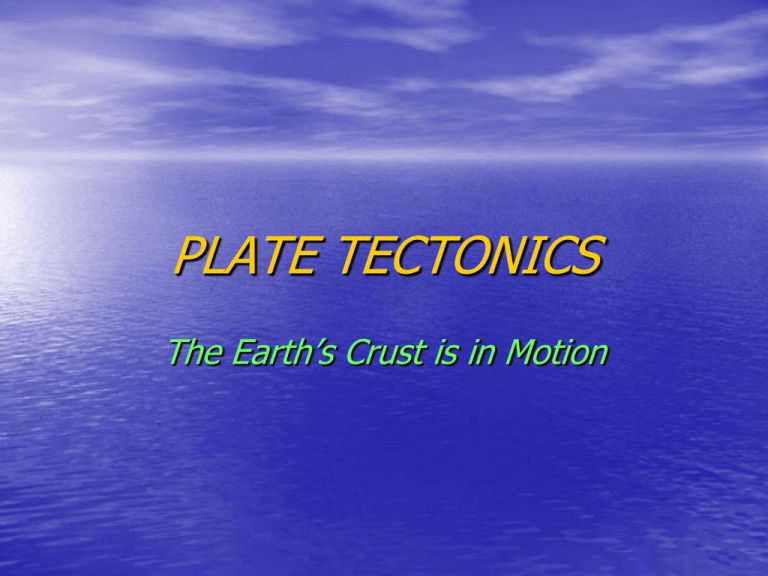Plate Tectonics PPT 13-14
advertisement

PLATE TECTONICS The Earth’s Crust is in Motion Relating Plate Tectonics to the Rock Cycle and other Processes http://earthsci.terc.edu/content/investigations/es0602/es0602page01.cfm ?chapter_no=investigation Structure of the Earth 1km=.621371 mi 4 Main Layers of the Earth Crust – Made up of two types: Oceanic and Continental. Contains mostly Silicon, Oxygen, and Aluminum Mantle – Divided into upper and lower mantle; mostly Iron and magnesium Outer Core – Liquid, mostly Iron and Nickel Inner Core – Solid, Mostly Iron and Nickel Layers of the Earth Comparison of Earth’s Two Types of Crust Oceanic Continental Thinner and more dense Made up mostly of mafic (basaltic) igneous rocks basalt and gabbro Thicker and less dense Made up mostly of the felsic (granitic) igneous rocks granite and rhyolite Theories Prior to Plate Tectonics Continental Drift Proposed by Alfred Wegener Says that the continents have moved horizontally to their present location Evidence for Continental Drift Continents fit together Fossils Continents fit like a puzzle Wegener called this large landmass Pangaea Fossils of similar animals such as mesosaurus and plants like glossopteris were found on different continents. (See fig. 2, p.273) Movement of the Continents Another View Evidence for Continental Drift (continued) Climate Rock Type and Structure Warm-weather fossils found in the Arctic Evidence of glaciers found in present-day warm areas. Same rock types and structures on different continents (example: Eastern U.S. and Western Europe Why was Wegener’s Original Proposal of Continental Drift not Accepted? Theories Prior to Plate Tectonics (continued) • Seafloor Spreading • Proposed by Harry Hess . • The theory states that hot, less dense material in the mantle is forced upward to the surface at the mid - ocean ridges. Seafloor Spreading (continued) • As magma is forced upward at mid-ocean • • ridges, it flows in opposite directions away from the ridge. As it moves away from the ridge, the magma cools, solidifies, gets thinner and becomes ___more___ dense. Becoming more dense than the asthenosphere below it, the oceanic crust sinks downward at convergent boundaries, forming trenches Evidence for Seafloor Spreading • Age of the Seafloor • Oceanic crust is younger • • than continental crust Oceanic crust is 160-180 million years old while continental crust is almost 4 billion years old. Rocks are younger at the mid-ocean ridges and get increasingly older away from the ridge on both sides Evidence for Seafloor Spreading (continued) • Magnetic Clues • Iron minerals in basaltic • • rocks align with the Earth’s magnetic field. The magnetic field has reversed several times. The reversal creates an alternating pattern of normal and reversed polarity that is the same on both sides of the ridge (see fig.7, p.278). Theory of Plate Tectonics • (Unifying theory that explains many complex Earth systems); • This theory helps explain continental _______, seafloor ________, AND provides a cause (mechanism) for these movements of the crust. • The cause was what was lacking in the previous theories. Theory of Plate Tectonics (cont.) • The theory of plate tectonics states that the Earth’s continental and oceanic crust is broken up into sections. These sections are called tectonic or lithospheric plates, and they move over the surface the Earth. • The larger plates and their boundaries can be seen in figure 9 on page 281. Layers Related to Plate Tectonics • Lithosphere • Consists of the crust and • • Asthenosphere rigid upper mantle Broken into large pieces called tectonic plates. • Plastic-like part of the • upper mantle. Is beneath the lithosphere Tectonic Plate Boundaries As the tectonic (lithospheric) plates move along and above the asthenosphere, the plates meet at three types of boundaries: • 3 Types of Boundaries • Divergent – plates • • move away from each other Convergent – plates move toward each other Transform – plates slide past each other horizontally Divergent Boundaries • The tectonic plates are moving away from each other • Characteristics of a divergent boundary are: - Shallow-focus Earthquakes - Volcanoes since molten material of the mantle is so close to the surface. • Examples of divergent boundaries are the Mid-Atlantic _______ and the East-African rift valley. A plume of hot magma rises from deep within the mantle pushing up the crust and causing pressure forcing the continent to break and separate. Lava flows and earthquakes would be seen. As the rift valley expands two continental plates have been constructed from the original one. The molten rock continues to push the crust apart creating new crust as it does. As the rift valley expands, water collects forming a sea. The sea floor continues to spread and the plates get bigger and bigger. Convergent Boundaries • Plates move towards each other • There are three types of convergent boundaries: 1) Oceanic-to-Continental 2) Oceanic-to-Oceanic 3) Continental-to-Continental Oceanic-to-Continental Convergent Boundaries • The more dense __oceanic_____ crust subducts under the less dense ____continental_______ crust. • Characteristics include: - Trench at subduction zone - Volcanoes - Shallow- and deep-focus earthquakes • An example is the __Andes____ mountains on the west coast of South America Andes Mountains in South America http://www.pbs.org/wnet/savageearth/animations/ Oceanic-to-Oceanic Convergent Boundaries An older, cooler, and _____ dense oceanic plate subducts under another oceanic plate Characteristics include: - Volcanic island arcs - Earthquakes and volcanoes - Ocean or sea on both sides of the boundary Examples of this type of boundary are Japan and the Aleutian Islands in Alaska Aleutian Island Chain, Alaska Aleutian Mountains Pavlof Volcano Continental-to-Continental Convergent Boundary This occurs when less –dense continental-crust plates collide. Being less dense, these plates can only move upward during collision. Characteristics include: - Tall mountains - Earthquakes (Shallow- and medium-focus) - Absence of __________ since there is no subduction. The Himalaya mountains where _____ and ____ collided are an example. Continental-to-Continental Convergent Boundary Collision of India and Asia Himalaya Mountains Transform Plate Boundaries At this boundary, the tectonic plates slide past each other with little or no vertical movement or subduction. Characteristics of a transform boundary: - Shallow-focus Earthquakes - An Absence of volcanoes since there is no subduction. An example of a transform boundary is the ___ _______ fault in California Transform Boundary Example Diagram of Transform Boundary Example of Transform Boundary Plate Boundary Summary Plate Boundary Summary Other Characteristics Related to Plate Tectonics Volcanoes and Earthquakes are concentrated along plate boundaries An example is the “ring of ____” around the Pacific Ocean (See figures 2 on page 301 and 5 on page 333) Earthquakes are Also Concentrated Along Plate Boundaries Other Characteristics of the Plate Tectonics Theory (continued) • An EXCEPTION to earthquakes and volcanoes being along plate boundaries is the occurrence of hot spots. • These occur where the mantle material is very close to the surface in isolated areas within a plate (See fig.8 on p.335) • An example of a hot spot is ________ Plate Moves over Hot Spot, Creating an Island Chain Map of Island Chain Created by the Hawaiian Hot Spot What Causes the Plates to Move? • The cause of tectonic (lithospheric) plate movement is __________ currents in the plastic-like mantle, or the __asthenosphere___________ • There are different models made to explain these convection_ currents (See figure 12 on page 285) Now, Repeat Everything Va. Tectonic landforms link http://filebox.vt.edu/users/shamner/EPortfolio/Lessonplans/PlateTectonics/Day%205.pdf









